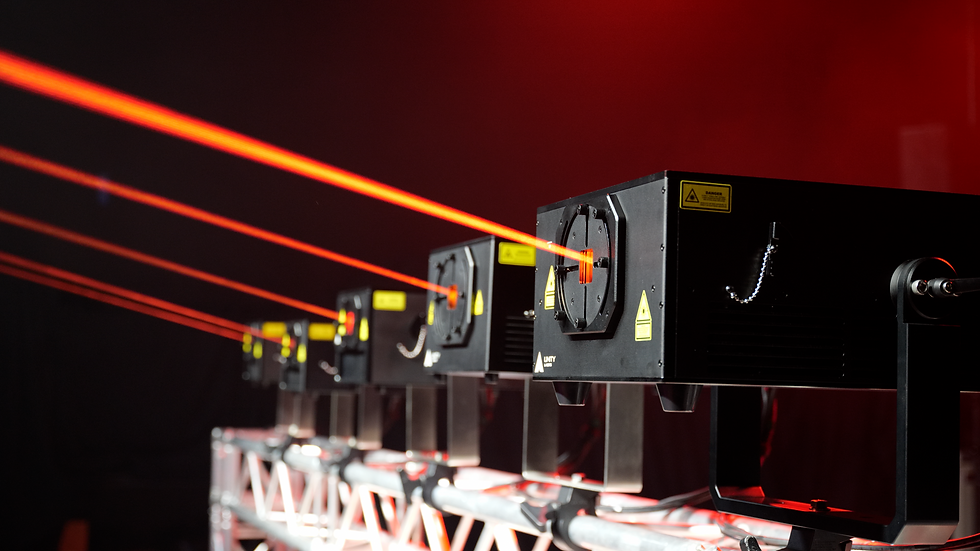X-Laser’s Triton T Series IP64 Lasers Have Arrived
- @LimeLightWired

- May 16, 2024
- 3 min read
X-Laser is the first to fully engineer and build IP64 laser fixtures in the U.S., and make them directly programmable from any pro console. Here’s the rundown.
X-Laser’s IP64 Lasers
X-Laser made a splash recently with its new Triton T Series IP64 laser fixtures. Available in two power levels, the 5W Triton T-5 and the 2W Triton T-2, these sturdy lasers were engineered for touring professionals who want to add lasers to their rigs without worrying about weather—or separate laser control.
X-Laser's well known Mercury firmware revolutionizes the integration of lasers into your programming workflow, making it seamless and efficient. This ease of integration makes these lasers an ideal choice for tours and shows on the go. While this is a significant advantage, many touring shows often perform in outdoor venues that demand IP-rated equipment. IP-rated lasers have only recently become available on the global market, and accessibility has been limited—until now. X-Laser's Triton T Series changes the game by providing readily accessible, high-quality IP64-rated laser fixtures designed for professional use in any environment.

X-Laser’s Triton T Series
X-Laser designed the Triton T Series from a truly clean sheet and made every engineering decision to optimize the user experience for every person on a tour, from the designer to the rigger. These Tritons share a compact housing design and only weigh about 20 pounds each. More importantly, the fixtures maintain IP64 durability whether mounted upright (taller and narrower) or laid flat (shorter and wider).

This means crews can easily rig them in whichever way fits best for their setup. Stage designers can specify large arrays of Triton T Series lasers on standard truss, or even fit several of these systems on a typical touring cart alongside other "regular" lights. This versatility also lets LDs craft looks with maximum laser coverage and empowers virtually limitless creative flexibility from such a high-impact fixture.

X-Laser’s Triton T-2 & T-5
Under the hood, the Triton T Series has industry-standard full RGB direct-injection laser diode modules, tuned to color mix on par with today’s top-line lights. Triton T Series lasers easily produce colors that are typically difficult for lasers to achieve, such as berry, CTO and lime, so LDs can pick their palettes with abandon.

The Triton T-2 and Triton T-5 also provide laser-specific advantages such as an unbelievable zoom range of 0.1º to 45º and instant zoom and digital “gobo” changes, making them suitable for all genres, venues and performances. If you haven’t heard, lasers aren’t just for EDM anymore.

X-Laser’s Mercury Firmware & Laser Safety
Of course, the Triton T-5 and Triton T-2 also include X-Laser’s exclusive Mercury firmware integrated, which allows programming directly from the lighting console using your preexisting show file and design workflow. There’s no need to mess with expensive license subscriptions for separate design software, and Mercury means absolutely no compromises or half-measure “solutions.” The Triton T Series fixtures, like any laser equipped with Mercury firmware, patch right in with traditional lights on the console. As designers expect, the Triton T Series uses common signal protocols such as DMX, sACN, Art-Net, and can run RDM, too.
We are well-acquainted with X-Laser's Mercury firmware. If you're not familiar with it, check out our demo to see how you can go from plugging and patching to a full-fledged laser show in minutes.
Importantly, X-Laser products are designed with safety in mind. X-Laser fixtures include built-in zoning capabilities, ensuring that laser output is only where intended—away from people, cameras, and reflective surfaces.
X-Laser Advantages
X-Laser has been trusted from your neighborhood music venue to giant tours like Coldplay. Their reputation is built on top-notch support, rigorous quality control processes, and reliable and dependable products.

We’ll dive deeper into the engineering details of the Triton T Series later this summer. For now, just know that they’re the only IP64 laser fixtures designed and built in the U.S., with as many external and internal components as possible that are actually made in-house at X-Laser HQ in Laurel, Maryland.
Check out www.x-laser.com/triton to be among the first to program with the power of Triton. You’ll soon realize—like so many lighting folks already have—that you’ve been sleeping on lasers for too long!











Comments